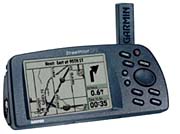
GARMIN STREETPILOT
GPS Receiver
Mounted between the handlebars of my motorcycle is a Garmin
StreetPilot, a GPS receiver which retails for about $400. No license or
subscription fee is required to receive the satellite signals. Good
quality GPS receivers, like the StreetPilot, can track up to 12 separate
satellites simultaneously. A signal from 3 satellites is required to fix
your position in latitude and longitude; four signals are required to
also determine your elevation. The more signals your GPS receiver is
picking up, the more accurate your location fix will be. When I crossed
the plains of North Dakota, the GPS had an accuracy of 33 feet. (In the
spring of 2000, SA, or Selective Availability, was turned off by the U.S.
government, making consumer GPS receivers even more accurate.) The StreetPilot unit contains a display that actually locates my
position on a moving map. The waterproof unit comes with a base map
containing many of the major streets and cities in the U.S. The GPS also
has a trip computer, which I reset every day. It tells me how many miles
Iíve traveled, my average speed, my maximum speed, as well as my time
spent moving and standing still. The StreetPilot also contains a clock
that receives the exact time, embedded in the satellite signal. It even
tells me when the sun will rise and set. The information is very
accurate, and much more reliable than a mechanical speedometer.
(Actually, most BMW motorcycle speedometers are a given percent over
actual. My R1100RS is 3.5 percent over, meaning that when Iíve
traveled 100 miles according to the GPS, the motorcycle will read 103.5
miles. This is why if youíve added up the miles traveled from my
journals each day, you would see they donít match the total listed.
For the total I use the BMW odometer because this is what I base the
bike maintenance on.) The real genius of the StreetPilot is that I can download
street-level, detailed information for the areas I will be traveling
through onto removable 16MB chips. Every few nights, depending on how far Iíve traveled, I
connect the unit to my laptop and download information from the Garmin
MapSource MetroGuide U.S.A. CD-ROM. This two-disc set contains every
possible street in the U.S., including little dirt roads. Without this
technology I would have to carry hundreds of maps. I look down at the
receiver and it tells me exactly where I am, what road Iím driving on,
my longitude, my latitude, and my altitude. Iím never lost. The downloaded MetroGuide information also contains a massive amount
of useful data. I can use it to find the nearest gas station, motel, and
even a National Park Site. Besides the actual location of places like
movie theaters and police stations, the data also contains phone numbers
for those points of interest. When I ran out of gas in western Texas,
the MetroGuide saved my butt. The auto club was going to take 2 hours to
reach me, but the phone number for a gas station 15 miles away was all I
needed to get moving. I was on the road in less than 30 minutes. Mounting the GPS unit onto your motorcycle is also a
bit of an issue. The best mount Iíve seen is made by Martin
Fabrication and sold through Cascade BMW. There are a variety of models
and mounting methods. I power the unit
directly off the motorcycle battery. The GPS is a wonderful tool and also a bit of a toy. If you want to
learn more about GPS check out the web sites listed below. If you are
interested in ordering some GPS equipment, I suggest TVNAV at
877-625-3546. Their web-site is located at http://www.tvnav.com.
Theyíve got the best prices on the Garmin units and accessories and
they aim to please. Darrell will probably answer the phone. Tell him
that Dan Cohen in New York referred you.
GPS on a motorcycle? Iíve
got to be kidding, right? Actually, I donít know how I would get by
without it. It just may be the most useful piece of equipment I have.
GPSís are starting to be offered as optional equipment in many
automobiles, and they are becoming quite a popular motorcycle add-on as
well.
 If
you donít know what it means, GPS stands for Global Positioning
System. Originally designed for military purposes, a constellation of 24
geo-synchronous satellites sends timed signals that are picked up by a
receiver and used to triangulate a position with extreme accuracy. The
signals are best received in open terrain, away from trees, buildings or
other features that obscure the sky. The satellites, maintained by the
U.S. Department of Defense, orbit the Earth every 12 hours at an
altitude of eleven thousand nautical miles.
If
you donít know what it means, GPS stands for Global Positioning
System. Originally designed for military purposes, a constellation of 24
geo-synchronous satellites sends timed signals that are picked up by a
receiver and used to triangulate a position with extreme accuracy. The
signals are best received in open terrain, away from trees, buildings or
other features that obscure the sky. The satellites, maintained by the
U.S. Department of Defense, orbit the Earth every 12 hours at an
altitude of eleven thousand nautical miles.
RELATED LINKS:
GARMIN'S WEB SITE
TVNAV'S
WEB SITE
PETER JONES'
GPS RIDERS
JOE MEHAFFEY and
JACK YEAZEL'S GPS SITE
MARTIN
FABRICATION GPS MOUNTS FOR MOTORCYCLES
| DREAM | JOURNEY
| IMAGES | STATS
| PARKS | MAPS
| GEAR | LINKS
| CREDIT | HOME |
COPYRIGHT © 2000 DANIEL COHEN. ALL RIGHTS RESERVED
DO NOT DISTRIBUTE ANY OF THESE DOCUMENTS,
OR PORTIONS
THEREIN, WITHOUT WRITTEN PERMISSION.
CONTACT 100DAYS@DANIELCOHEN.ORG CONCERNING QUESTIONS OR
COMMENTS.